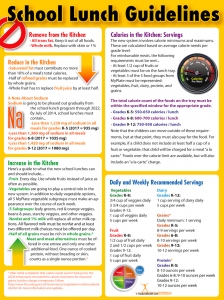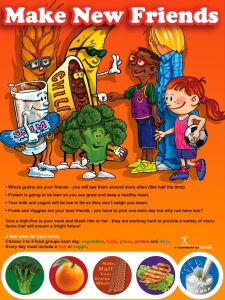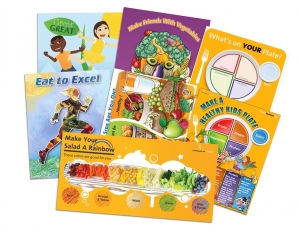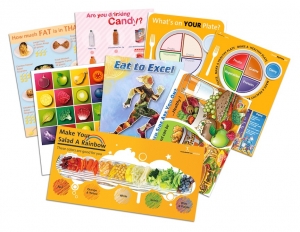USDA School Policy Update: What You Need to Know for Fall
 Did you know that children eat an average of 1/2 to 2/3 of their daily calories at school?School nutrition policy is constantly changing, often in order to find the best strategies to fight obesity. Lately, the USDA has been updating school nutrition policies and programs like crazy! Are you ready for fall and the implementation of new phases in many of these programs?Let's take a look at the most recent developments...Smart Snack Initiative:The Smart Snacks in School rules will affect over 100,000 elementary, middle, and high schools that accept assistance from the National School Lunch Program.These rules will apply to foods from...
Did you know that children eat an average of 1/2 to 2/3 of their daily calories at school?School nutrition policy is constantly changing, often in order to find the best strategies to fight obesity. Lately, the USDA has been updating school nutrition policies and programs like crazy! Are you ready for fall and the implementation of new phases in many of these programs?Let's take a look at the most recent developments...Smart Snack Initiative:The Smart Snacks in School rules will affect over 100,000 elementary, middle, and high schools that accept assistance from the National School Lunch Program.These rules will apply to foods from...
- A la carte lines
- Fundraisers
- Student stores
- Vending machines
So, what are the rules? Let's take a look at the highlights. For more detail, view the comprehensive rule guide.
- Grain-based products must be at least 50 percent whole-grain or have whole grains as the first ingredient.
- Other products must have fruit, vegetable, dairy, or protein as a first ingredient.
- There are limits on the levels of fat, sugar, sodium, caffeine, and calories of the foods in this category.
- Only a certain number of school fundraisers may be exempt from these requirements.
This initiative has already taken effect, going into action on July 1st, 2014.Want more information? Check out the rules and regulations from the USDA. MyPlate School Lunch Update:But wait, there's more! Let's look at the latest details from the MyPlate conference earlier this month.This fall, schools will be shifting into a new implementation phase for school lunch policy. The details of what is going to be changing are featured below, though more information can be found through the USDA's Food and Nutrition Service.For school breakfast and lunch...
MyPlate School Lunch Update:But wait, there's more! Let's look at the latest details from the MyPlate conference earlier this month.This fall, schools will be shifting into a new implementation phase for school lunch policy. The details of what is going to be changing are featured below, though more information can be found through the USDA's Food and Nutrition Service.For school breakfast and lunch...
- All grains have to be whole grain rich.
- How rich?
- Each item must have at least 50% of its grains as whole grains.
- All foods must hit the first round of sodium targets.
- Breakfast sodium targets
- Grades K-5: ? 540 milligrams (mg) of sodium
- Grades 6-8: ? 600 mg of sodium
- Grades 9-12: ? 640 mg of sodium
- Lunch sodium targets
- Grades K-5: ? 1,230 mg of sodium
- Grades 6-8: ? 1,360 mg of sodium
- Grades 9-12: ? 1,420 mg of sodium
- Breakfast sodium targets
- Breakfast must include the offer of a cup of fruit, but children do not have to take it or may take less than a cup.
 Healthy, Hunger-Free Kids Act:This act was passed in 2010 and authorizes funding and sets policy for the USDA's core child nutrition programs. These programs include...
Healthy, Hunger-Free Kids Act:This act was passed in 2010 and authorizes funding and sets policy for the USDA's core child nutrition programs. These programs include...
- The Child and Adult Care Food Program
- The National School Lunch Program
- The School Breakfast Program
- The Special Supplemental Nutrition Program for Women, Infants and Children (WIC)
- The Summer Food Service Program
So what's the update?Well, earlier this year, the USDA proposed regulations to create a framework and guidelines for written wellness policies established by Local Education Agencies (LEAs) for Local School Wellness Policy.Want more detail? View the regulations.Resources for You:We want to do our part to make these transitions as effective and easy as possible. Check out these great resources! Past looks at USDA programs and policy:
Past looks at USDA programs and policy:
- USDA School Snack Guide - Smart Snack List for Parents, Teachers and School Foodservice Directors
- USDA Publishes Standards for Snack Foods for Schools
- School Lunches: A Look at New Policy
- Dietary Guidelines 2015: Schedule and Policy
Free handouts to promote healthful choices:
Additional nutrition education materials:
- Basic Nutrition Poster Set (perfect for cafeteria decorations)
- Nutrition PowerPoint Presentation
- Fruit and Vegetable Balloons
- Healthful Eating Game
Of course, there's always more in the Nutrition Education Store! Check out these great resources for schools!



